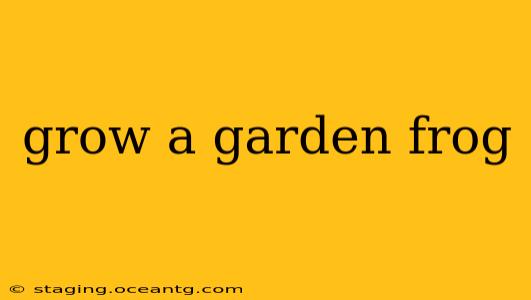Frogs are beneficial additions to any garden, acting as natural pest control and adding a touch of wild beauty. Instead of trying to grow a frog (which isn't possible; frogs need to develop naturally in their environment), let's focus on how to create a garden that attracts and supports a thriving frog population. This involves providing the right habitat, food source, and protection.
What conditions do garden frogs need to thrive?
Frogs need a specific set of conditions to thrive. These include a reliable water source, ample hiding places, and a sufficient food supply. The water source should be clean and relatively still, like a pond or a birdbath. Hiding places can be provided by rocks, logs, dense vegetation, and leaf litter. The food source largely depends on the frog species, but typically involves insects and other small invertebrates.
What kind of plants attract frogs to a garden?
Planting a variety of native plants is key to attracting frogs. These plants provide shelter, attract insects (the frogs' food), and offer a natural look and feel that frogs prefer over manicured landscapes. Consider plants that offer dense foliage, like ferns, hostas, and other shade-loving plants. Include some taller plants for climbing insects and to provide dappled shade for the frogs. Native aquatic plants are vital if you have a pond.
How can I build a frog-friendly pond in my garden?
Building a frog-friendly pond is a great way to attract and support frogs. Aim for a shallow, gently sloping edge, so frogs can easily enter and exit the water. Include rocks and plants both in and around the pond to provide shelter and basking spots. Avoid using chemicals or pesticides near the pond, as these can harm the frogs and their prey. Consider adding a small waterfall or bubbler to keep the water oxygenated, as stagnant water can be harmful to amphibian life.
What insects are frogs attracted to?
Frogs are insectivores, primarily feeding on insects like mosquitos, flies, crickets, grasshoppers, and beetles. By creating a habitat that supports a diverse insect population, you'll naturally attract frogs. This can be achieved through the use of wildflowers and diverse plant life.
Are there any specific frog species suitable for gardens?
Many frog species are suitable for gardens, depending on your geographic location and climate. Research the native frog species in your area to determine which are most likely to thrive in your garden. It's important to remember that you shouldn't try to move frogs from their natural habitat; attracting them to your garden is a much more ethical and sustainable approach.
What are the best ways to protect garden frogs from predators?
Protecting garden frogs from predators, such as snakes, birds, and larger animals, is important for their survival. Providing ample hiding places within dense vegetation and beneath rocks and logs will greatly increase their chances of evading predators. Maintaining a healthy ecosystem will support the overall biodiversity of your garden, reducing pressure on the frog population. Avoid using pesticides, as these can harm the frogs directly or indirectly through their food sources.
By following these guidelines, you can create a thriving garden that attracts and supports a healthy population of frogs. Remember, patience is key, and creating the right habitat is crucial for attracting these fascinating amphibians to your outdoor space. With a little effort, you can transform your garden into a haven for frogs and other beneficial wildlife.
